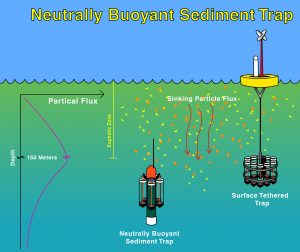Neutrally Buoyant Sediment Traps (NBSTs) and Twilight Zone Explorer (TZEX)
What is an NBST?
Open ended cylinders and cones have been used for decades to collect sinking particles in the ocean. These so-called "sediment traps" are generally either fixed to the bottom of the ocean on a mooring, or suspended from floating tethers. We have recently developed and tested an improved sediment trap that is designed around a neutrally buoyant float. Since ocean particles sink slowly (10's-100's m/day) relative to ocean currents (km/day) it becomes extremely difficult to collect particles from a fixed or slowly moving platform—sort of like trying to use a rain gauge in a hurricane. The Neutrally Buoyant Sediment Trap (NBST) drifts with the currents, thus eliminating hydrodynamic effects which can lead to particle sorting and flux biases. Our NBST opens up a new window to study more accurately the rain of particles out of the upper ocean, which is a key pathway that links the surface ocean to deep waters.

On This Page
Development (top)
In 1994 Jim Valdes, Ken Buesseler & James Price were awarded a Cecil H. & Ida M. Green Technology Innovation Award to build what had been a longtime idea. The first tests of NBSTs were performed in the summer of 1996 using a glass hull material. While able to withstand high pressures at depth, the fragility of the material during deployment and recovery proved to be an issue after it hit the side of the ship and promptly sank. An aluminum hull then replaced the glass, however programming and mechanical issues resulted in some losses. Not to be deterred they were successfully tested off Bermuda in the summer of 1997 paving the way for many research projects to come. The tests were chronicled in the article "A New Way to Catch Rain" in the WHOI publication Oceanus, Fall/Winter 1997.
NBSTs on VERTIGO (top)
The first major NSF funded project to use NBSTs was VERTIGO with field tests on a 2004 cruise off Hawaii and chronicled by Peter Spott "Voyage to the Ocean's 'Twilight Zone' in the Christian Science Monitor. Seven were deployed, and luckily seven came back!
They were then used on two subsequent VERTIGO cruises in summer 2004 off Hawaii and at site K2 in summer 2005. Use of this equipment on board is described in a few blog posts written by a variety of authors at sea. These include how to find them once they surface and the technologies used and ballasting and their development.
Trap Comparisons (top)
On VERTIGO numerous other sediment trap types were used, including traditional sediment traps, 'Clap' Traps. Previous testing at the BATS site off Bermuda indicated wide ranging compositional and relative flux differences attributed to particle sorting. Results of trap comparisons were written up in the following documents:
Buesseler, K.O. (1991) Do upper-ocean sediment traps provide an accurate record of particle flux? Letters to Nature, 353(3), 420-423.
Buesseler, K.O., Steinberg, D.K., Michaels, A.F., Johnson, R.J., Andrews, J.E., Valdes, J.R., and J.F. Price (2000). A comparison of the quantity and quality of material caught in a neutrally buoyant versus surface-tethered sediment trap (PDF). Deep-Sea Res I, 47, 277-294.
Valdes, J.R, and J.F. Price (2000). A Neutrally Buoyant, Upper Ocean Sediment Trap (PDF). Journal of Atmospheric and Oceanographic Technology, 17(1), 62-68.
Stanley, R.H.R., K.O. Buesseler, S.J. Manganini, D.K. Steinberg and J.R. Valdes (2004). A Comparison of Major and Minor Elemental Fluxes collected using Neutrally Buoyant and Surface-Tethered Traps (PDF). Deep-Sea Research Part I, 51, 1387-1395.